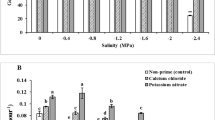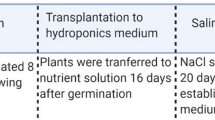Abstract
Salinity stress is one of the most serious environmental factors limiting plant growth and productivity in large areas around the world. Priming approach was adopted to study the effect of glycinebetaine (GB) on enhancing salt tolerance of sensitive wheat cultivar (Gomeza 7). The caryopsis were primed in different concentrations of GB (25, 50, 100 mM) for 24 h, and then treated with or without 150 mM NaCl added to 1/4-modified Hoagland solution (MHS). The NaCl treatment lasted 38 d under natural environmental conditions. Salt stress reduced all growth parameters measured: fresh mass, dry mass, relative growth rate, for the shoots and roots, and relative water content (RWC). Salt imposition increased the level of Na+ and Cl−, and reduced Ca+2 and K+ levels in both shoots and roots. Exogenous application of GB alleviated the deleterious effects of salinity on growth and mineral contents, the effect was more pronounced with 25 mM GB. Priming of caryopsis in GB counteracted the increase in the plasma membrane (PM) permeability and increased the cell solute potential, which was decreased by salinity. GB priming also increased the GB and glutathione concentrations, and reduced proline (Pro) as well as lipid peroxidation. Salt tolerance enhancement by GB priming might be occurred through reduced lipid peroxidation, increased GB and glutathione resulting in PM protection, and eventually ion homeostasis. The study is a valuable confirmation for enhancing salt adaptation via GB priming, which is of general interest for agriculture practices.
Similar content being viewed by others
Abbreviations
- Ψs:
-
cell solute potential
- GB:
-
glycinebetaine
- MDA:
-
malondialdehyde
- MHS:
-
modified Hoagland solution
- Ks:
-
permeability coefficient
- Pro:
-
proline
References
Anjum N.A., Aref I.M., Durate A.C., Pereira E., Ahmad I. & Iqbal M. 2014. Glutathione and proline co-ordinately make plants withstand the joint attack of metal(loid) and salinity stresses. Front. Plant Sci. 5: doi: 10.3389/fpls.2014.00662.
Arafa A.A., Khafagy M.A. & El-Banna M.F. 2009. The effect of glycinebetaine or ascorbic acid on grain germination and leaf structure of sorghum plants grown under salinity stress. Plant Nutr. 5: 294–304.
Ashraf M. & Foolad M.R. 2007. Roles of glycinebetaine and proline in improving plant abiotic stress resistance. Environ. Exp. Bot. 59: 206–216.
Barrett-Lennard E. & Setter E. 2010. Developing saline agriculture moving from traits and genes to systems. Funct. Plant Biol. 37: 3–5.
Bates L.S., Waldren I.D. & Tare I. 1973. Rapid determination of free proline for water stress studies. Plant Soil 13: 875–883.
Beutler E., Durgun O. & Kelly B.M. 1963. Improved method for the determination of blood glutathione. J. Lab. Clin. Med. 51: 882–888.
Bohnert H.J., Nelson D.E. & Jensen G.R. 1995. Adaptation to environmental stresses. Plant Cell 7: 1099–1111.
Bor M., Ozdemir F. & Turkan I. 2003. The effect of salt stress on lipid peroxidation and antioxidants in leaves of sugar beet Beta vulgaris L. and wild beet Beta maritima L. Plant Sci. 164: 77–84.
Cha-um S., Supaibulwatana K. & Kirdmanee C. 2006. Water relations, photosynthetic ability and growth of Thai rice (Oryza sativa L. ssp. Indica cv. KDML 105) to salt stress by application of exogenous glycinebetaine and choline. J. Agron. Crop Sci. 192: 25–36.
Chen T.H.H. & Murata N. 2008. Glycinebetaine: an effective pro-tectant against abiotic stress in plants. Trends Plant Sci. 13: 499–505.
Colmer T.D., Munns R. & Flowers T.J. 2006. Improving salt tolerance of wheat and barley: Future prospects. Animal Prod. Sci. 45: 1437–1447.
Demiral T. & Turkan I. 2004. Does exogenous glycinebetaine affect antioxidative system of rice seedlings under NaCl treatment? J. Plant Physiol. 161: 1089–1100.
Demiral T. & Turkan I. 2006. Comparative lipid peroxidation, antioxidant defense systems and proline content in roots of two rice cultivars differing in salt tolerance. Environ. Exp. Bot. 53: 247–257.
Epstein E. 1972. Mineral Nutrition of Plants. Principles and Perspectives. Wiley, New York.
FAO 2004. The state of food insecurity in the world. https://doi.org/www.fao.Org/3/a-y650e3/a-y650e.
FAO 2008. Land and plant nutrition management service. https://doi.org/www.fao.Org/ag/agl/spushag/agl/spush.
Farooq S. & Azam F. 2006. The use of cell membrane stability technique to screen for salt tolerant wheat varieties. J. Plant Physiol. 163: 629–637.
Flowers T.J., Galal H.K. & Bromhamt N. 2010. Evaluation of halophytes origins of salt tolerance in Land plants. Funct. Plant Biol. 37: 604–612.
Foyer C.H. & Noctor G. 2005. Oxidant and antioxidant signaling in plants: A re-evaluation of the concept of oxidative stress in physiological context. Plant Cell Environ. 28: 1056–1071.
Grieve C. & Maas E.V. 1984. Betaine accumulation in salt stressed Sorghum. Physiol. Plant. 61: 167–171.
Hunt R. 1981. Plant growth analysis. In: Studies in biology. Eduard Arnold, London.
Hussain M., Malik M.A., Farooq M., Khan M.B., Akram M. & Saleem M.F. 2009. Exogenous glycinebetaine and salicylic acid application improves water relations, allometry and quality of hybrid sunflower under water deficit conditions. J. Agron. Crop Sci. 195: 98–109.
Jisha K.C., Vijayakumari K. & Puthur J.T. 2013. Seed priming for abiotic stress tolerance: an overview. Acta Physiol. Plant. 35: 1381–1396.
Kaya C., Sonmez O., Aydemir S. & Dikilitas M. 2013. Mitigation effects of glycinebetaine on oxidative stress and some key growth parameters of maize exposed to salt stress. Turk J. Agric. Forest. 37: 188–194.
Khafagy M. A., Arafa A.A. & El-Banna M.F. 2009. Glycinbetaine and ascorbic acid can alleviate the harmful effects of NaCl salinity in sweet pepper. Plant Nutr. 5: 257–267.
Longxing H., Tao H., Zhang X., Pang H. & Jinmin F. 2012. Exogenous glycinbetaine ameliorate the adverse effect of salt stress on perennial Rayegrass. J. Amer. Soc. Hort. Sci. 137: 38–46.
Mansour M.M.F., Lee-Stadelmann O.Y. & Stadelmann E.J. 1993. Salinity stress and cytoplasmic factors. A comparison of cell permeability and lipid partiality in salt sensitive and salt resistant cultivars and lines of Triticum aestivum and Hordium vulgare. Physiol. Plant. 88: 141–148.
Mansour M.M.F. 1995. Changes in cell membrane permeability and lipid content of wheat root cortex cells induced by NaCl. Biol. Plant. 37: 143–145.
Mansour M.M.F. 1998. Protection of plasma membrane of onion epidermal cells by glycinebetaine and proline against NaCl stress. Plant Physiol. Biochem. 36: 767–772.
Mansour M.M.F. 2000. Nitrogen containing compounds and adaptation of plants to salinity stress. Biol. Plant. 43: 491–500.
Mansour M.M.F., Salama K.H.A., Al-Mutawa M.M. & Abou Hadid A.F. 2002. Effect of NaCl and polyamines on plasma membrane lipids of wheat roots. Biol. Plant. 45: 235–239.
Mansour M.M.F., & Salama K.H.A. 2004. Cellular basis of salinity tolerance in plant. Environ. Exp. Bot. 52: 113–122.
Mansour M.M.F., Salama K.H.A., Ali F.Z.M. & Abou Hadid A.F. 2005. Cell and plant responses to NaCl in (Zea mays L.) cultivars differing in salt tolerance. Gen. Appl. Plant Physiol. 31: 29–41.
Mansour M.M.F. 2013. Plasma membrane permeability as an indicator of salt tolerance in plants. Biol. Plant. 57: 1–10.
Mansour M.M.F. 2014. The plasma membrane transport systems and adaptation to salinity. J. Plant Physiol. 171: 1787–1800.
Mansour M.M.F., Salama K.H.A. & Allam H.Y.H., 2015. Role of the plasma membrane in saline conditions: lipids and proteins. Bot. Rev., DOI: https://doi.org/10.1007/s12229-015-9156-4.
Meloni D.A. & Martinez C.A. 2009. Glycinebetaine improves salt tolerance in vinal (Prosopis ruscifolia Griesbach) seedlings. Braz. J. Plant Physiol. 21: 233–241.
Munns R. 1985. Na+, K+, Cl− in xylem sap flowing to shoots of NaCl treated barley. J. Exp. Bot. 36: 1032–1042.
Munns R. & Tester M. 2008. Mechanisms of salinity tolerance. Annu. Rev. Plant Biol. 59: 651–681.
Naqvi S.S., Mumtaz S., Ali S.A., Khan A.H., Ashraf M.Y. & Khan M.A. 1994. Proline accumulation under salinity. Is abscisic acid involved? Acta Physiol. Plant. 16: 117–22.
Nawaz K. & Ashraf M. 2007. Improvement in salt tolerance of maize by exogenous application of glycinebetaine: growth and water relations. Pak. J. Bot. 39: 1647–1653.
Nawaz K. & Ashraf M. 2010. Exogenous application of glycinebetaine modulate activities of antioxidants in maize plants subjected to salt stress. J. Agron. Crop Sci. 196: 28–37.
Ohkawa H., Ohishi N. & Yagi K. 1979. Assay for lipid peroxides in animal tissues by thiobarbituric acid reaction. Anal. Biochem. 95: 351–358.
Qadir M., Tubeilch A., Akktan J., Larbi A., Minbas P. & Khan M. 2008. Productivity enhancement of salt-affected environments through crop diversification, pp. 22–39. In: Staples R.C. & Toenniessen G.H. (eds), Salinity Tolerance in Plants, Strategies for Crop Improvement, Wiley, New York.
Ranganna S. 1977. Manual of analysis of fruit and vegetable product, (2nd edition), McGraw-Hill, New Delhi.
Raza S.H., Athar H.R., Ashraf M. & Hameed A. 2007. Glycinebetaine-induced modulation of antioxidant enzymes activities and ion accumulation in two wheat cultivars differing in salt tolerance. Environ. Exp. Bot. 60: 368–376.
Salama K.H.A. 2009. Amelioration of NaCl-induced alterations on the plasma membrane of Allium cepa L. by ascorbic acid. Aust. J. Basic Appl. Sci. 3: 990–994.
Salama K.H.A & Mansour M.M.F. 2015. Choline priming-induced plasma membrane lipid alterations contributed to improved wheat salt tolerance. Acta Physiol. Plant. 37: 170.
Shalhevet J. 1993. Plant under salt and water stress, pp. 178–190. In: Fowden L., Mansfield T. & Stoddart J. (eds), Plant Adaptation to Environmental Stress, Chapman and Hall, London.
Srivastava A.K., Singh K., Ghosha A.K., Darash R., Rai R.K., Shunkla S.P. & Singh K. 1989. Uptake and partitioning of sodium and chloride ions in sugarcane. Sugarcane 4: 3–6.
Stadelmann E.J. & Lee-Stadelmann O.Y. 1989. Passive permeability. Methods Enzymol. 174: 143–216.
Steduto P., Katerji N., Puertos-Molina H., Mastrorilli M. & Rana G. 1997. Water-use efficiency of sweet sorghum under water stress conditions: Gas-exchange investigations at leaf and canopy scales. Field Crops Res. 54: 221–234.
Tao R. & Gao M. 2003. Technologies for improving tolerance to environmental stress: genetic engineering of salt stress tolerance in Japanese persimmon (Diospyros kaki) with the genes involved in biosynthesis of compatible solute. Acta Horti. 625: 307–320.
Author information
Authors and Affiliations
Corresponding author
Rights and permissions
About this article
Cite this article
Salama, K.H.A., Mansour, M.M.F. & Al-Malawi, H.A. Glycinebetaine priming improves salt tolerance of wheat. Biologia 70, 1334–1339 (2015). https://doi.org/10.1515/biolog-2015-0150
Received:
Accepted:
Published:
Issue Date:
DOI: https://doi.org/10.1515/biolog-2015-0150




